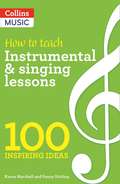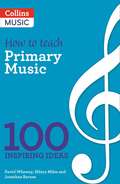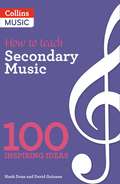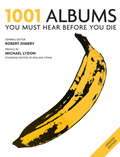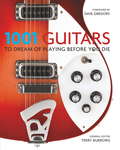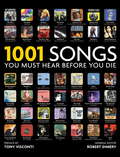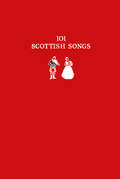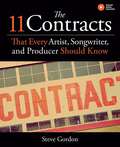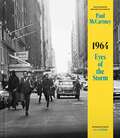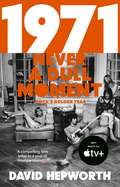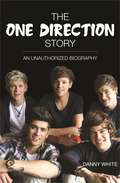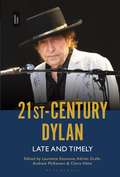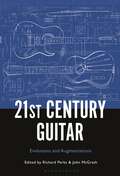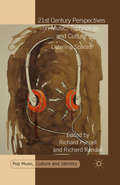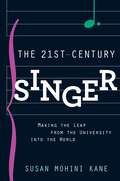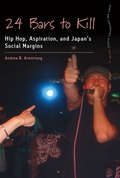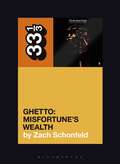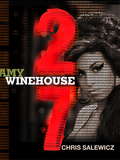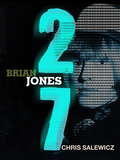- Table View
- List View
100 Ideas For Music: Instrumental And Singing Teaching (PDF)
by A C A C BlackHow to teach Instrumental and Singing lessons presents 100 diverse ideas for teachers of every instrument. The ideas are concise, easy to implement and tackle everything from scales, sight-reading and performance anxiety to group teaching, special needs and business practicalities. This practical handbook will invigorate lessons with any pupil.
100 Ideas For Primary Teachers: Making Musical Schools (PDF)
by David Wheway Hilary Miles Jonathan Barnes100 Ideas provides simple ideas, which are easy to implement, to make primary schools more musical. There are very few resources for primary schools which provide easy dip-in ideas on how to incorporate music within the school day and this book brings together a large number of ideas to inspire and equip teachers, and share good and innovative practice. Music doesn't have to be scary, and there are lots of ways to use music throughout the whole school, in and outside of the curriculum, and at different times of the year. These easy dip-in ideas and activities go across the spectrum, with ideas teachers can take on board easily. * Musical activities * Warm-ups and skill builders * Singing assemblies * Putting on a school musical * Simple concert performances * Inclusion * Liaising with visiting music teachers * Technology * School recordings & CDs * Composers of the week * Visual displays * After-school clubs * Greeting and goodbye songs * Songs to instruct children for activities (make a circle) * Supporting the curriculum music * Liaising with music hubs and external musicians
100 Ideas For Secondary Teachers: Outstanding Music Department (PDF)
by My-Hanh Doan Dave Guinane100 Ideas for and Outstanding Music Department would provided much needed ideas for secondary music school teachers across the UK and Ireland. There are very few resources for music departments, yet many interesting initiatives being pioneered and shared over social media amongst other networks. This book would compile together a large number of ideas to inspire and equip new teachers, and share good and innovative practice. The 100 Ideas for Teachers series offers early years, primary and secondary practitioners/teachers quick and practical ideas, tips, advice and/or activities to improve specific areas of their teaching in an accessible, dip in and out format. In making this relevant for a Secondary Music Department, My-Hanh Doan and Dave Guinane have focussed on four main areas: the classroom, extra-curricular activities, the department and the wider school. Their ideas cover Key Stage 3 to A-level, and cover areas from behaviour, homework, kick-starting orchestras through to ensembles, trips and tours, social media strategies and much more. An invaluable resource for every secondary teacher.
100% Unofficial: More Idols of K-Pop
by Natasha MulengaThe ultimate guide to the world of K-Pop! Even more stats, gossip and pics of your favourite bands including BTS, BlackPink and many more!
1001 Albums You Must Hear Before You Die: You Must Hear Before You Die (1001)
by Robert DimeryWhat did Time magazine consider the twentieth-century's greatest album? Which anthem by Prince was an attempt to emulate Bob Seger? And what links Count Basie and Batman?If you thought you knew your music, then think again. 1001Albums You Must Hear Before You Die, is totally revised and fully updated for 2013, and is the definitive guide to accompany your interest in music. Written by top UK and US music journalists, and includes a preface by Michael Lydon, the founding editor of the Rolling Stone magazine. It celebrates the great and ground-breaking albums throughout the eras - from the genesis of Fifties rock 'n' roll to the technological and electronic innovations of the 2000s.Each entry includes key tracks and explains exactly why each of these albums deserved to be included in the list, offering an insight into the process of their creation, development, and success. With albums from Elvis Presley, Frank Sinatra, Miles Davis, The Rolling Stones, Bob Dylan, The Sex Pistols, ACDC, Ray Price, the Beach Boys, Sonic Youth, P J Harvey, Jack White, Green Day, Christina Aguilera, and the latest from David Bowie, as well as new cutting-edge entries such as Kendrick Lamar and Django Django, 1001 Albums You Must Hear Before You Die covers all the works that have formed part of the soundtracks to all our lives, at one point or another.Illustrated with more than 900 iconic images of album covers, bands and artists, as well as photographs from many legendary gigs, 1001 Albums You Must Hear Before You Die, covers from the 1950s to the present and is the single most comprehensive list of music that changed the world, an absolute must-have for all the musically inspired.
1001 Guitars to Dream of Playing Before You Die (1001)
by Terry BurrowsFind out why Chet Atkins had a Gretsch guitar named after him, why The Who's John Entwistle called his favourite guitar "Frankenstein", and how John Lennon elevated the Rickenbacker 325 to one of the most desirable guitar brands of the 1960's.1001 Guitars to Dream of Playing Before Your Die showcases the greatest instruments from across the globe: some are of historical or cultural significance and some were made famous by well-known musicians; others are included as examples of technological breakthroughs, innovative design or extraordinary sound quality. From the earliest models produced by Belchior Dias in the sixteenth century to the latest Gibson "Robot" series of guitars with computer-controlled self-tuning capabilities and onboard sound-processing features, 1001 Guitars to Dream of Playing Before Your Die tells the fascinating stories behind the creation of each one.All the classic names are here - Fender, Roland, Martin, Gretsch and Rickenbacker - as well as important Japanise brands, such as Ibanez, Yamaha and Teisco; European classics of the 1960's including Burns, Hagstrom, Eko and Hofner; obscure models from behind the "Iron Curtain", such as Defil, Aelita, Resonet and Musima; and present-day oil-can guitars built in South Africa. Never before have so many guitars been profiled within a single illustrated volume.A striking colour photograph of each guitar is accompanied by specification details and illuminating text that traces the guitar's history and reveals which famous musicians like to play the instrument and on what albums it can be heard. Contents includes... IntroductionPre -1930s1930 - 1949 1950s1960s1970s1980s1990s2000s
1001 Songs: You Must Hear Before You Die (1001)
by Robert DimeryWhat links Lead Belly, Lonnie Donegan and Black Betty? Whose gravestoneinspired Phil Spector's first hit? And for which song did Johnny Rotten replace the singer from Def Leppard?The rich history of popular music is built on a foundation of classic songs. From Tin Pan Alley to the Brill Building, Bob Dylan to Kurt Cobain, and Joni Mitchell to Amy Winehouse, gifted songwriters have crafted a cherished body of music that has become part of our lives. Imagine the Fifties without the magical clamor of "Tutti Frutti" and "Hound Dog" the Seventies without the anthemic "Le Freak" and "Anarchy in the UK" or the Noughties without the Leftfield pop of "Toxic" or "Crazy". This music mirrors the times, both reflecting society at large ("A Change is Gonna Come", "The Message") and mapping our own personal highs ("God Only Knows") or lows ("Hurt"). And from 'Saturday Night Fish Fry' to Saturday Night Fever, it has helped us simply forget our problems.1001 Songs You Must Hear Before You Diepicks through nearly a century of music to bring you an inspiring selection of some of the greatest recordings ever made. Each entry in this wonderfully browsable book tells the story of a great song. Find out what inspired the songwriter, what makes the track so enduring, which songs it influenced in turn and which cover version to listen out for. You'll also pick up a wealth of fascinating trivia along the way.
101 Scottish Songs: The Wee Red Book (Collins Scottish Archive)
by Norman BuchanA small format gift book which is a reproduction of the popular book ‘101 Scottish Songs’ published by Collins in 1962. Popularized as ‘the wee red songbook’ in Scottish folk circles, this publication was in print for 26 years.
The 11 Contracts That Every Artist, Songwriter and Producer Should Know: (pdf)
by Steve GordonThe 11 Contracts Every Artist, Songwriter, and Producer Should Know is an in-depth guide to help artists, songwriters, and producers navigate the tricky world of contract negotiations in the music industry. This book analyzes the most common, and important, contracts including management, production company, sync license, and producer agreements all paired with professional commentary and exclusive interviews with top industry moguls. Readers will learn the ins and outs of both the legal and business side of contracts in the music industry so that they will never find themselves stuck on the wrong side of a bad deal. Features invaluable information on these 11 crucial music industry contracts: * Management Agreements * Production Company and New Artist * Indie Label Deals * Sync Licenses * Producer Agreements * Music Publishing Deals * Composer Agreements * Live Performance Contracts * Music Video Production Contracts * Band Agreements & Business Actions Artists Can Take Without an Attorney * Investment Agreements
1964: Eyes Of The Storm
by Paul McCartneyPhotographs and Reflections by Paul McCartney'Millions of eyes were suddenly upon us, creating a picture I will never forget for the rest of my life.'In 2020, an extraordinary trove of nearly a thousand photographs taken by Paul McCartney on a 35mm camera was re-discovered in his archive. They intimately record the months towards the end of 1963 and beginning of 1964 when Beatlemania erupted in the UK and, after the band's first visit to the USA, they became the most famous people on the planet. The photographs are McCartney's personal record of this explosive time, when he was, as he puts it, in the 'Eyes of the Storm'.1964: Eyes of the Storm presents 275 of McCartney's photographs from the six cities of these intense, legendary months - Liverpool, London, Paris, New York, Washington, D.C. and Miami - and many never-before-seen portraits of John, George and Ringo. In his Foreword and Introductions to these city portfolios, McCartney remembers 'what else can you call it - pandemonium' and conveys his impressions of Britain and America in 1964 - the moment when the culture changed and the Sixties really began.1964: Eyes of the Storm includes:- Six city portfolios - Liverpool, London, Paris, New York, Washington, D.C. and Miami - and a Coda on the later months of 1964 - featuring 275 of Paul McCartney's photographs and his candid reflections on them- A Foreword by Paul McCartney- Beatleland, an Introduction by Harvard historian and New Yorker essayist Jill Lepore- A Preface by Nicholas Cullinan, Director of the National Portrait Gallery, London, and Another Lens, an essay by Senior Curator Rosie Broadley
1971 - Never a Dull Moment: Rock's Golden Year
by David HepworthThe Sixties ended a year late – on New Year's Eve 1970, when Paul McCartney initiated proceedings to wind up The Beatles. Music would never be the same again.The next day would see the dawning of a new era. 1971 saw the release of more monumental albums than any year before or since and the establishment of a pantheon of stars to dominate the next forty years – Led Zeppelin, David Bowie, the Rolling Stones, Pink Floyd, Marvin Gaye, Carole King, Joni Mitchell, Rod Stewart, the solo Beatles and more.January that year fired the gun on an unrepeatable surge of creativity, technological innovation, blissful ignorance, naked ambition and outrageous good fortune. By December rock had exploded into the mainstream. How did it happen? This book tells you how. It's the story of 1971, rock’s golden year.
1D - The One Direction Story: An Unauthorized Biography
by Danny WhiteThe biography of the hugely successful British band One Direction, who shot to fame after taking the seventh series of The X-Factor by storm. 1D: The One Direction Story explores the backgrounds, early lives and motivations of Niall, Liam, Zayn, Harry and Louis from obscurity all the way to international stardom. Covering how the boys coped with the exposure of The X-Factor, their new celebrity status and the experiences around hugely successful, chart-topping singles, a BRIT award and a number one album in America, this is the definitive book for all One Direction fans.
21st-Century Dylan: Late and Timely
by Laurence Estanove, Adrian Grafe, Andrew McKeown and Claire HélieBob Dylan has constantly reinvented the persona known as “Bob Dylan,” renewing the performance possibilities inherent in his songs, from acoustic folk, to electric rock and a late, hybrid style which even hints at so-called world music and Latin American tones. Then in 2016, his achievements outside of performance – as a songwriter – were acknowledged when he was awarded the Nobel Literature Prize. Dylan has never ceased to broaden the range of his creative identity, taking in painting, film, acting and prose writing, as well as advertising and even own-brand commercial production. The book highlights how Dylan has brought his persona(e) to different art forms and cultural arenas, and how they in turn have also created these personae. This volume consists of multidisciplinary essays written by cultural historians, musicologists, literary academics and film experts, including contributions by critics Christopher Ricks and Nina Goss. Together, the essays reveal Dylan's continuing artistic development and self-fashioning, as well as the making of a certain legitimized Dylan through critical and public recognition in the new millennium.
21st-Century Dylan: Late and Timely
Bob Dylan has constantly reinvented the persona known as “Bob Dylan,” renewing the performance possibilities inherent in his songs, from acoustic folk, to electric rock and a late, hybrid style which even hints at so-called world music and Latin American tones. Then in 2016, his achievements outside of performance – as a songwriter – were acknowledged when he was awarded the Nobel Literature Prize. Dylan has never ceased to broaden the range of his creative identity, taking in painting, film, acting and prose writing, as well as advertising and even own-brand commercial production. The book highlights how Dylan has brought his persona(e) to different art forms and cultural arenas, and how they in turn have also created these personae. This volume consists of multidisciplinary essays written by cultural historians, musicologists, literary academics and film experts, including contributions by critics Christopher Ricks and Nina Goss. Together, the essays reveal Dylan's continuing artistic development and self-fashioning, as well as the making of a certain legitimized Dylan through critical and public recognition in the new millennium.
21st Century Guitar: Evolutions and Augmentations
by John McGrath Richard PerksIn the 21st Century, the guitar, as both a material object and tool for artistic expression, continues to be reimagined and reinvented. From simple adaptations or modifications made by performers themselves, to custom-made instruments commissioned to fulfil specific functions, to the mass production of new lines of commercially available instruments, the extant and emergent forms of this much-loved musical instrument vary perhaps more than ever before. As guitars sporting multiple necks, a greater number of strings, and additional frets become increasingly common, so too do those with reduced registers, fewer strings, and fretless fingerboards. Furthermore, as we approach the mark of the first quarter-century, the role of technology in relation to the guitar's protean nature is proving key, from the use of external effects units to synergies with computers and AR headsets. Such wide-ranging evolutions and augmentations of the guitar reflect the advancing creative and expressive needs of the modern guitarist and offer myriad new affordances.21st Century Guitar examines the diverse physical manifestations of the guitar across the modern performative landscape through a series of essays and interviews. Academics, performers and dual-practitioners provide significant insights into the rich array of guitar-based performance practices emerging and thriving in this century, inviting a reassessment of the guitar's identity, physicality and sound-creating possibilities.
21st Century Guitar: Evolutions and Augmentations
by Richard Perks and John McGrathIn the 21st Century, the guitar, as both a material object and tool for artistic expression, continues to be reimagined and reinvented. From simple adaptations or modifications made by performers themselves, to custom-made instruments commissioned to fulfil specific functions, to the mass production of new lines of commercially available instruments, the extant and emergent forms of this much-loved musical instrument vary perhaps more than ever before. As guitars sporting multiple necks, a greater number of strings, and additional frets become increasingly common, so too do those with reduced registers, fewer strings, and fretless fingerboards. Furthermore, as we approach the mark of the first quarter-century, the role of technology in relation to the guitar's protean nature is proving key, from the use of external effects units to synergies with computers and AR headsets. Such wide-ranging evolutions and augmentations of the guitar reflect the advancing creative and expressive needs of the modern guitarist and offer myriad new affordances.21st Century Guitar examines the diverse physical manifestations of the guitar across the modern performative landscape through a series of essays and interviews. Academics, performers and dual-practitioners provide significant insights into the rich array of guitar-based performance practices emerging and thriving in this century, inviting a reassessment of the guitar's identity, physicality and sound-creating possibilities.
21st Century Perspectives on Music, Technology, and Culture: Listening Spaces (Pop Music, Culture and Identity)
by R. Purcell R. RandallThis collection presents a contemporary evaluation of the changing structures of music delivery and enjoyment. Exploring the confluence of music consumption, burgeoning technology, and contemporary culture; this volume focuses on issues of musical communities and the politics of media.
The 21st Century Singer: Making the Leap from the University into the World
by Susan Mohini KaneThe vast majority of singers with a degree in performance are un- or under-employed in their field. Despite the fact that talented singers are discovered every day, there are far too few jobs in the field of classical music to accommodate all of them, a problem evidenced by regular reports of opera companies and symphony orchestras closing their doors. Young classical singers, particularly recent graduates of music programs, need not only artistic ability, but also intelligence and an acute business sense to navigate the world of professional singing. In The 21st-Century Singer: Making the Leap from the University into the World , author Susan Mohini Kane has created a user-friendly guide for these recent graduates. Kane combines the benefits of an instructional manual with those of a self-reflective workbook to provide emerging classical singers with both practical and inspirational advice. She begins with a section on self-evaluation, allowing readers to define what motivates their desire to sing professionally and reflect on their passions, before moving on to career advice. In the sections that follow, Kane presents a variety of career paths, such as singing, teaching, and consulting-realistic alternatives to the rise to stardom as an "overnight sensation" that so few will experience-and provides the reader with the tools to develop a concrete plan for whichever path they decide to pursue. Other sections offer instruction on how to develop support systems, train oneself holistically, and take advantage of the newest technological resources available for professional self-promotion. With its dual emphasis on artistic motivation and modern-day business sense, The 21st-Century Singer will prove an essential text for anyone pursuing a professional singing career.
21ST CENTURY SINGER C: Making the Leap from the University into the World
by Susan Mohini KaneThe vast majority of singers with a degree in performance are un- or under-employed in their field. Despite the fact that talented singers are discovered every day, there are far too few jobs in the field of classical music to accommodate all of them, a problem evidenced by regular reports of opera companies and symphony orchestras closing their doors. Young classical singers, particularly recent graduates of music programs, need not only artistic ability, but also intelligence and an acute business sense to navigate the world of professional singing. In The 21st-Century Singer: Making the Leap from the University into the World , author Susan Mohini Kane has created a user-friendly guide for these recent graduates. Kane combines the benefits of an instructional manual with those of a self-reflective workbook to provide emerging classical singers with both practical and inspirational advice. She begins with a section on self-evaluation, allowing readers to define what motivates their desire to sing professionally and reflect on their passions, before moving on to career advice. In the sections that follow, Kane presents a variety of career paths, such as singing, teaching, and consulting-realistic alternatives to the rise to stardom as an "overnight sensation" that so few will experience-and provides the reader with the tools to develop a concrete plan for whichever path they decide to pursue. Other sections offer instruction on how to develop support systems, train oneself holistically, and take advantage of the newest technological resources available for professional self-promotion. With its dual emphasis on artistic motivation and modern-day business sense, The 21st-Century Singer will prove an essential text for anyone pursuing a professional singing career.
24 Bars to Kill: Hip Hop, Aspiration, and Japan's Social Margins (Dance and Performance Studies #14)
by Andrew B. ArmstrongThe most clearly identifiable and popular form of Japanese hip-hop, “ghetto” or “gangsta” music has much in common with its corresponding American subgenres, including its portrayal of life on the margins, confrontational style, and aspirational “rags-to-riches” narratives. Contrary to depictions of an ethnically and economically homogeneous Japan, gangsta J-hop gives voice to the suffering, deprivation, and social exclusion experienced by many modern Japanese. 24 Bars to Kill offers a fascinating ethnographic account of this music as well as the subculture around it, showing how gangsta hip-hop arises from widespread dissatisfaction and malaise.
24-Carat Black's Ghetto: Misfortune's Wealth (33 1/3)
by Zach SchonfeldIn 1973, the musical collective 24-Carat Black released an unheralded masterpiece on Stax Records-and then disappeared. Ghetto: Misfortune's Wealth, a soul-funk concept album primarily written by the ex-Motown arranger Dale Warren, was too bleak, ambitious, or just outright bizarre to reach mainstream audiences. 24-Carat Black collapsed when Stax went bankrupt, and the group's only completed album sank into cultural obscurity. With deep reporting elucidating an untold story full of cinematic details, this book traces how Ghetto went from commercial flop to enigmatic underground classic embraced by the hip-hop community. It also chronicles, in infuriating detail, how the music industry of the 1970s systematically exploited soul musicians and then left them struggling to get paid-and where 24-Carat Black fits into this broader injustice. This is a fascinating and multilayered story about a remarkable album nearly lost to history. It's also a rare glimpse into what it's like to have your music resurrected by rap samples decades after your career fell apart.
24-Carat Black's Ghetto: Misfortune's Wealth (33 1/3 #152)
by Zach SchonfeldIn 1973, the musical collective 24-Carat Black released an unheralded masterpiece on Stax Records-and then disappeared. Ghetto: Misfortune's Wealth, a soul-funk concept album primarily written by the ex-Motown arranger Dale Warren, was too bleak, ambitious, or just outright bizarre to reach mainstream audiences. 24-Carat Black collapsed when Stax went bankrupt, and the group's only completed album sank into cultural obscurity. With deep reporting elucidating an untold story full of cinematic details, this book traces how Ghetto went from commercial flop to enigmatic underground classic embraced by the hip-hop community. It also chronicles, in infuriating detail, how the music industry of the 1970s systematically exploited soul musicians and then left them struggling to get paid-and where 24-Carat Black fits into this broader injustice. This is a fascinating and multilayered story about a remarkable album nearly lost to history. It's also a rare glimpse into what it's like to have your music resurrected by rap samples decades after your career fell apart.
27: Amy Winehouse (The 27 Club Series #1)
by Chris SalewiczIn 27: Amy Winehouse, the first in a series of exclusive ebooks, acclaimed music writer Chris Salewicz celebrates the life of one of the most talented performers of recent times. In an intimate mini-biography, he explores Amy's artistic influences and inspirations, her ability to capture the imagination and her appetite for self-destruction. Salewicz provides a startling portrayal of the perils of genius and the true cost of fame. Must the ferociously good die young?
27: Brian Jones (The 27 Club Series #3)
by Chris SalewiczBrian Jones, multi-instrumentalist, visionary and the 'golden boy of the '60s', was, at the age of 27, the first rock casualty of his generation.A strange, somewhat impenetrable character, Brian Jones was a founding member and guiding spirit of The Rolling Stones. Adored and misunderstood in equal measure, Jones was perhaps the most creatively ambitious cultural force of his time, an artist whose commitment to the experimental and exotic remains profoundly influential.Always unconventional, Jones's voracious appetite for life's extremes led to unparalleled debauchery, drug and alcohol fuelled paranoia, and ultimately personal ruin.27: Brian Jones is the third in a series of exclusive music ebooks, an ambitious project examining the perils of genius, celebrity and excess. Other titles in the series include 27: Amy Winehouse, 27: Jimi Hendrix, 27: Jim Morrison and 27: Kurt Cobain.
27: Janis Joplin (The 27 Club Series #5)
by Chris SalewiczJanis Joplin, singer-songwriter, counterculture icon, the Queen of rock and roll, died aged just 27. During a short four-year career, blighted by alcoholism and drug abuse, she changed the face of music, carving out opportunities for a generation of female talent. Her powerful, raw vocals touched fans of folk music, blues and soul alike, with recordings such as 'Me and Bobby McGee', 'To Love Somebody' and 'Mercedes Benz' widely recognized as classics of their era.In 27: Janis Joplin acclaimed author Chris Salewicz examines Joplin's troubled and unconventional existence, and explains her profound musical influence. This is the fifth in a series of exclusive music ebooks, an ambitious project examining the perils of genius, celebrity and excess. Other titles in the series include 27: Amy Winehouse, 27: Kurt Cobain, 27: Brian Jones, and 27: Jimi Hendrix.
